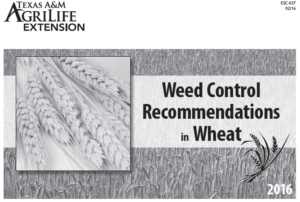Dr. Calvin Trostle, Extension Agronomy, Dept. of Soil & Crop Sciences, Texas A&M AgriLife/Texas A&M University, Lubbock, 806-746-6101, ctrostle@ag.tamu.edu
In 2015 I wrote about sensitivity of small grains—wheat specifically—to 2,4-D products, dicamba, and MCPA. I noted a handy guide from Purdue University that explained the differences between 2,4-D amines and 2,4-D esters, which discussed the pros and cons of these two formulations. You can review that earlier newsletter at https://agrilife.org/texasrowcrops/2015/03/04/24-d-and-sensitivity-in-small-grains/ The link noted there for the Purdue guide is https://mdc.itap.purdue.edu/item.asp?itemID=18343 (or directly from https://www.panna.org/sites/default/files/2,4-D%20Amine%20or%20Ester%202004-Purdue.pdf)
2,4-D and Sensitivity in Small Grains
There remains a discrepancy among some chemical manufacturers on the label about 2,4-D products and when the can vs. should (or should not) be applied in winter wheat. Even Texas A&M AgriLife guidance on the use of 2,4-D and timing of application for winter wheat is not consistent.
Examples of chemical label comments (all accessed via http://www.cdms.net):
• 2,4-D Amine (Albaugh): Apply after the crop is fully tillered, but before boot stage of growth (usually 4 to 8” tall) but not forming joints in the stem. Do not apply before tillering or from early boot through the milk stage of growth.
• 2,4-D Amine 600 (Loveland): Treat in the spring between full tillering and just before flag leaf stage. Do not apply during and after the flag leaf stage.
• 2,4-D Ester LV6 (Winfield): Apply only in the spring when crop is fully tillered, but before grain is in boot stage (Zadoks 40, Feekes 10.0).
• 2,4-D Ester LV6 (Albaugh): Apply after crop is fully tillered, but before boot stage of growth (usually 4 to 8 inches) tall but not forming joints in the stem.
• An AgriLife Extension summary of all 2,4-D products (Amine, LV4 Ester, LV6 Ester (Texas A&M AgriLife Weed Control Recommendations in Wheat, ESC-037, see below): Apply in the spring when wheat is in full tiller but before boot stage. Crop may be injured at higher rates.
As noted in 2015 Texas A&M AgriLife Extension has for a long time taken a conservative approach to the use of 2,4-D products, dicamba, and MCPA (2-methy-4-chlorophenoxyacetic acid) in wheat due to injury concerns. Former state extension small grains specialist Dr. Travis Miller discusses 2,4-D in relation to wheat growth and development in “Growth Stages of Wheat: Identification and Understanding Improve Crop Management,” http://varietytesting.tamu.edu/wheat/docs/mime-5.pdf
Safer Use of 2,4-D in Wheat
In this wheat growth guide, Dr. Miller notes that by Feekes growth stage 6.0—first node visible (which means jointing is occurring, see figures in 2015 document)—any and all applications of phenoxy herbicides like 2,4-D, MCPA, and dicamba should have been completed. These chemicals can be translocated to the growing point (developing head) and cause potential injury. In contrast, sulfonylurea herbicide products are labeled to initial boot stage or even initial flag leaf emergence, but for practical reasons weed control should have been completed by now.
These comments contrast with the above label recommendations. Several of these labels do caution, however, that producers should either refrain from 2,4-D applications or reduce the rate if injury is not acceptable.
I reiterate that the ideal use of 2,4-D is to control early small weed populations, when they are easier to address. In this regard to some extent phenoxy applications after jointing should be moot.
Weed Control Recommendations in Wheat (Texas A&M AgriLife Extension, ESC-037)
This guide was updated in 2016 by Dr. Clark Neely and colleagues. It lists at the time all known chemicals labeled for wheat and other small grains. This includes the following:
• Brand product names (check http://www.cdms.net for generic labels)
• Application rate per acre
• Weeds controlled
• Recommended maximum height for application of herbicide
• General remarks
• Tank-mix options
• Whether other small grains (barley, oats, rye, triticale) are also labeled.
This document should help you plan your weed control strategy in wheat and other small grains. It will help you more readily identify options. It is NOT a substitute for the labels. You should confirm AgriLife’s summary information from the label. And as always, remember to follow chemical label directions.
